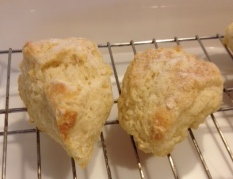Oven temperature. . .we’re talking oven temperature here!
I have baked hundreds of scones in the last decade. So, when a friend asked me to bake scones for her daughter’s wedding shower, I agreed. This would be fun AND easy. Make the dough up in advance, and get up early enough to bake before leaving for the shower.
The first batch into the oven was ‘plain’ Original Recipe. I preheated the oven to 405 degrees (it runs hot so this is the setting that gives me 425 degrees). The scones came out of the freezer, were set onto a parchment lined cookie sheet, placed into the oven. I set timer for 18 minutes and moved on.
At the end of 18 minutes, I checked the oven and was horrified! My scones had spread laterally, and had minimal rise. The bottoms of the scones were suspiciously white, and there was a puddle of melted butter around each scone. In short, they were not baked.
I second-guessed everything I did. Did I prep the dough correctly? (YES) What had I done differently? Then I looked at the problem again. The scones were not baked. So, I found the oven thermometer and put it in the hot oven to confirm the oven temperature. Sure enough, my oven was running at a mere 360 degrees rather than 425 degrees. This is not nearly hot enough to properly bake scones. I made a simple adjustment to the settings and the next two batches of scones baked up perfectly. They had a nice rise, good color, and baked within the normal baking time.
 Look carefully–the scone on the right baked at the unexpectedly lower oven temperature. It is flatter and more spread out. It was very tasty, but it didn’t have the same light texture or appearance as the scone on the left.
Look carefully–the scone on the right baked at the unexpectedly lower oven temperature. It is flatter and more spread out. It was very tasty, but it didn’t have the same light texture or appearance as the scone on the left.
Scones and biscuits both need a hot, quick bake. The high, quick heat is needed to turn that butter into nice steamy air pockets without leaving pools of butter on the cookie sheet.
As for my temperamental oven? A faulty igniter (gas oven) is the culprit, and repair is scheduled next week.

 Cart
Cart